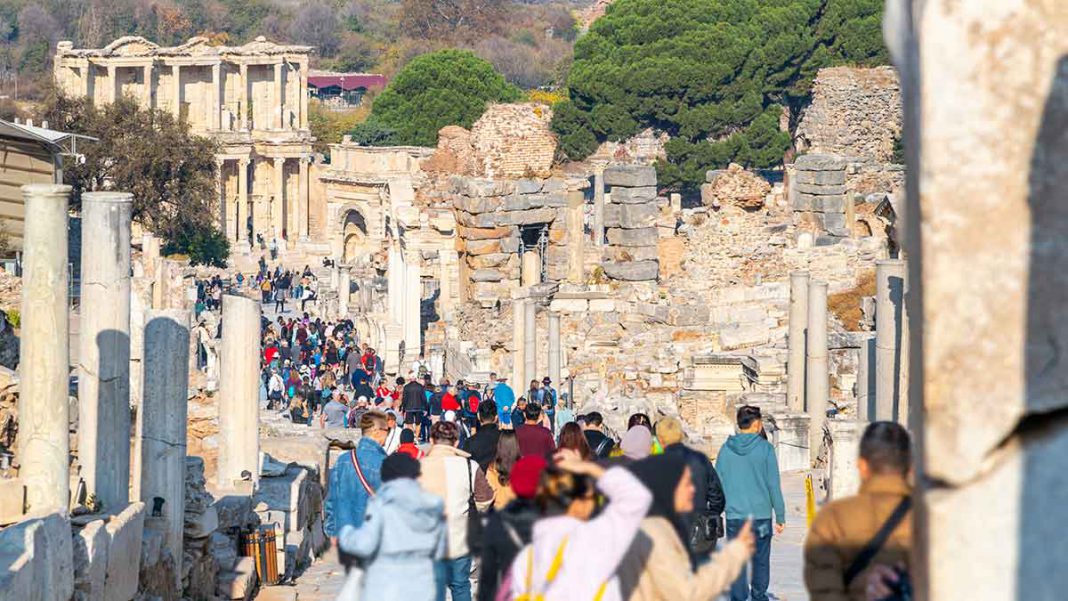When Louvre museum workers staged a walkout last month over unbearable crowding, it wasn’t just a labor protest; it was a sign of a system stretched to its limits. From Europe’s most iconic landmarks to fragile island ecosystems, the global tourism industry is facing a moment of reckoning. The return of mass travel in the post-pandemic era – often framed as “revenge tourism”- has revived a long-standing crisis: Overtourism.
According to the World Travel & Tourism Council (WTTC), overtourism occurs when the impact of tourism negatively affects the quality of life for residents and the experience of visitors. It’s not just about visitor numbers, but what happens when those numbers overwhelm a destination’s capacity to sustainably handle them – causing overcrowding, environmental damage, inflated prices, and rising local resentment.
Beyond the Selfie: The Reality of Overtourism
From Venice to Machu Picchu, the signs are clear. Cruise ship bans, timed ticketing, fines for vandalism and anti-tourist graffiti reflect the growing pushback against mass tourism. In many cities, short-term rentals have driven up housing costs for locals, while popular neighborhoods are reduced to tourist staging grounds, stripped of their original character. And this transformation is not confined to wealthy nations. Overtourism is a global issue, impacting fragile ecosystems in Southeast Asia, heritage sites in Africa and spiritual destinations in Latin America. The WTTC emphasizes that even in developing countries, the growth of tourism must be managed to avoid irreversible environmental and social degradation.
WTTC’s Role: Balancing Growth and Responsibility
The WTTC, the global authority on travel and tourism’s economic and social impact, has been at the forefront of addressing overtourism. While the sector accounts for 10% of global GDP and supports over 300 million jobs worldwide, the WTTC stresses that this growth must be balanced with environmental and social sustainability.
To this end, the Council supports initiatives such as:
Promoting responsible visitor behavior
Encouraging destination diversification
Advising governments on sustainable infrastructure investments
Supporting innovation in sustainable fuels and mobility
Their position is clear: the tourism sector must not only drive economic growth but also preserve the quality of life and the environment in host destinations.
Solutions in Action: A Global Scan
Different regions are experimenting with new tools and policies to address overtourism:
Japan has introduced reservation-only systems for popular sites to control footfall.
Cannes, France will ban large cruise ships starting 2026 to reduce pollution and overcrowding.
Amsterdam is actively rebranding and reducing “party tourism” through advertising restrictions and bans on new hotels.
Italy fined ticket scalpers at the Colosseum and raised prices for non-EU tourists at major cultural sites, aiming to balance access with preservation.
Bhutan remains a standout with its “high-value, low-impact” model, requiring a sustainable development fee from international tourists.
These policies may differ, but they share a common goal: ensuring that tourism enhances, rather than erodes, the places people love to visit.
The Economics of Sustainability
The WTTC highlights that economic prosperity through tourism must not come at the cost of social friction and environmental harm. Unchecked, overtourism can backfire: stressed infrastructure, unhappy residents and declining visitor satisfaction ultimately reduce the attractiveness and profitability of a destination.
Experts like Doug Lansky, a destination management and tourism specialist, propose models akin to Disney’s “fast pass” system, where longer stays or higher-value tourism gets tiered access. “If destinations are treated like national parks, then access can be a privilege based on care and respect and not just the ability to pay,” he notes.
Cities are also experimenting with real-time visitor data, smart crowd control and digital passes that reward off-peak or off-beat travel, spreading demand across time and geography.
What Travelers Must Do Differently
While systemic change is essential, travelers themselves are a crucial part of the solution. As the WTTC notes, responsible tourism behavior is one of the most direct ways to mitigate overtourism.
Here’s how travelers can help:
Avoid peak season and explore destinations in the off-season.
Seek lesser-known places, distributing footfall and spending.
Respect local customs and communities; you are a guest.
Book with sustainable operators and support local businesses.
Be aware of your footprint – physical, cultural and carbon.
The Road Ahead: A Call for Collaboration
Overtourism isn’t just a travel issue. It is also a climate issue, a housing issue, a cultural preservation issue. It cuts across policy, economics, technology and ethics. The WTTC urges collaboration across sectors to accelerate solutions, from scaling sustainable aviation fuel to building cleaner transport and greener infrastructure. It’s also calling on the travel and tourism industry to work closely with local communities to ensure shared benefits and minimized harm.
As the sector continues to grow, the challenge is clear: we must redefine what “successful tourism” looks like in a crowded world.
Travel is a gift, but in 2025, it’s also a responsibility. The choices we make on where we go, how we go and how we behave, will shape the future of the places we love. Overtourism is not inevitable. With thoughtful policy, smart technology and informed travelers, the industry can pivot to a more sustainable, inclusive, and respectful model.
In the words of the WTTC: “The future of tourism depends on what we do today.”


